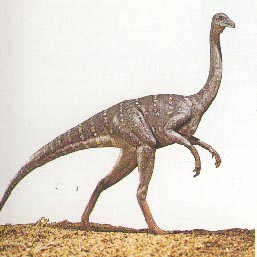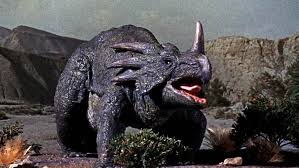
Since the days of the Apocalypse, the world has forever changed. Now, with the seas risen and the warming of the Earth and Sky, much of the world is covered in strange life, some of it very different than that found in the Anthropocene. But these changes are not only mutations or engineered versions of earlier forms, though such is clearly evident. Some come seemingly from the ancient past, far before the Age of Man. Now reports of terrible reptilian beasts from the Age of Dinosaurs stalking the wild corners of the world, easily competing with all but the most terrible of mutants. These savage beings are well suited to the rigors of the changed Earth of the Atomic Dawn, and have been pushing deeper and deeper into settled lands.
But where have these primordial beasts come from? Even the most ambitious geneticist would be hard pressed to find viable DNA amidst the fossil remains of these awesome creatures. The answer to this is far weirder.
The parallel dimension known as Agartha, is a world where prehistoric life has continued to develop unabated. This alternate plane is believed to have overlapped with our own many times in the past, the largest believed to have been the Lost Continent of Mu. Since the apocalypse, such overlapping zones and portals have once again occurred in remote locales such as deep swamps, jungles and in underground regions. Whether or not these portals are natural or created by the denizens of that realm (see Aliens) is unknown, though what is known is that dinosaurs and other things come through and quickly find our world much to their liking.
Other creatures native to Agartha (and great for Lost World Regions) found in the Mutant Future Rulebook are: Ant (Giant), Bee (Giant Killer), Carcass Scavenger, Centipede (Giant), Crab (Giant), Fish (Giant), Insect Swarm, Leech (Giant), Lizard (Giant), Morningstar Plants, Rhagodessa (Giant), Scorpion (Giant), Snake (All), Spider (Giant- All Varieties), Toad (Giant),
Sample Creatures
Below are some of the dinosaurs seen across Merica in recent years. There are other varieties, but the following have been of immediate concern to the Alamo Empire, and thus more details are available. Mutant versions of these creatures do exist, and are always impressive.
Culloo (Pteranodon)
 No. Enc.: 1 (1d4)
No. Enc.: 1 (1d4)Alignment: Neutral
Movement: Fly: 240ft (120ft)
Armor Class: 6
Hit Dice: 5
Attacks: 1 (bite)
Damage: 1d12
Save: L3
Morale: 8
Hoard Class: VII
A large predatory dinosaur with enormous leathery wings that can span up to 50ft. Culloo haunt cliffs near water hunting fish and small game such as squirrels, monkeys and other creatures found in treetops or along riverbanks. Any who have business near waterways is advised to be very watchful for culloo, as they are known man-eaters and will carry off children or small adults if given half a chance.
Mutations: None.
Gillygaloo (Ornithomimus)
 No. Enc.: 1 (3d10)
No. Enc.: 1 (3d10)Alignment: Neutral
Movement: 240ft (80ft)
Armor Class: 7
Hit Dice: 2
Attacks: 1 (butt)
Damage: 1d4
Save: L1
Morale: 2
Hoard Class: None
Gillygaloo are 7 ft long, running reptiles that resemble birds. They breed quickly and have been showing up in all over Merica, particularly in the southwest. Ranchers hate these creatures, as they spook herd beasts and horses and have been known to snatch domestic fowl. Fortunately gillygaloo and their eggs are very tasty, though whether or not they can be domesticated remains to be seen. Gillygaloo flesh is comparable to lamb and their eggs large enough to count as a dozen chicken eggs.
Mutations: None.
Gwangi (Allotyrannus*)
 "He who takes from Gwangi the evil one is cursed." -Tia Zorina, Wise Woman
"He who takes from Gwangi the evil one is cursed." -Tia Zorina, Wise WomanNo. Enc.: 0 (1)
Alignment: Neutral
Movement: 120ft (40ft)
Armor Class: 3
Hit Dice: 15
Attacks: 1 (bite)
Damage: 4d6
Save: L7
Morale: 11
Hoard Class: VII x3
The Gwangi (Gwaan-Gee) is a ferocious and adaptable predatory reptile that averages 15ft tall and 25ft long from nose to tail. Gwangi are fast and cunning foes, hunting anything that moves. Ranchers in particular are concerned about these beasts, as herds of rabboxen, cattle and horses are extremely tempting to Gwangi, who prefer the relatively easy prey of domestic stock.
Gwangi are generally solitary creatures gathering only for mating, after which the female will be left to tend to the eggs and resulting young. Female gwangi make surprisingly good parents, burying the eggs in rotting vegetation and tending to the young dinosaurs until they reach young adulthood. Male gwangi are cannibals however, and will eat even their own young if an opportunity presents itself.
Mutations: None.
*A species particular to Agartha.
Piasa Bird (Pterodactyl)
 No. Enc.: 1 (2d4)
No. Enc.: 1 (2d4)Alignment: Neutral
Movement: Fly: 180ft (60ft)
Armor Class: 7
Hit Dice: 1
Attacks: 1 (bite)
Damage: 1d3
Save: L1
Morale: 7
Hoard Class: None
These winged reptiles are usually found along rivers and in swamps, but can show up in almost any non arctic environment. The Piasa have leathery wings that span 7 to 10 feet. They glide through the air, watching for prey on the ground. Fishermen despise Piasa Birds, as these creatures are daring and clever thieves, tearing into all but the toughest nets to steal fish. Fish farms find a constant watch must be kept lest these beasts wipe out the entire stock in a few days.
Piasa birds are not normally dangerous unless frightened, but sometimes will attack children or lone persons if food has been scarce or if frightened. When they do attack, it is in large numbers and of a "bite and run" variety.
Mutations: None.
Vangon (Styracosaurus)
 No. Enc.: 0 (1d4)
No. Enc.: 0 (1d4)Alignment: Neutral
Movement: 120ft (40ft)
Armor Class: 2
Hit Dice: 8
Attacks: 1 (gore or trample)
Damage: 2d6 or 2d12
Save: L4
Morale: 6
Hoard Class: None
These large, 18ft long reptiles are herbivores, but very aggressive to those who come near. They live in grassy environments in sub-tropical and temperate regions. These creatures have a tall straight nose horn, and a neck frill crowned with at least four large spikes. Like other large animals, a vangon may charge during the first round of combat to inflict double damage.
Female vangon live in maternal herds which include other females and their offspring. Male offspring leave their maternal herd when around three years old and will either live alone or join other males in bachelor herds. Male and female herds do not mingle until the breeding season. During the breeding season, dominant males maintain a small harem of females for mating. Individual bulls "tend" females until allowed to mate, by following them around and chasing away rival males. It is during this mating season when vangon are the most aggressive.
Mutations: None.



1 comment:
Good Stuff!
Post a Comment